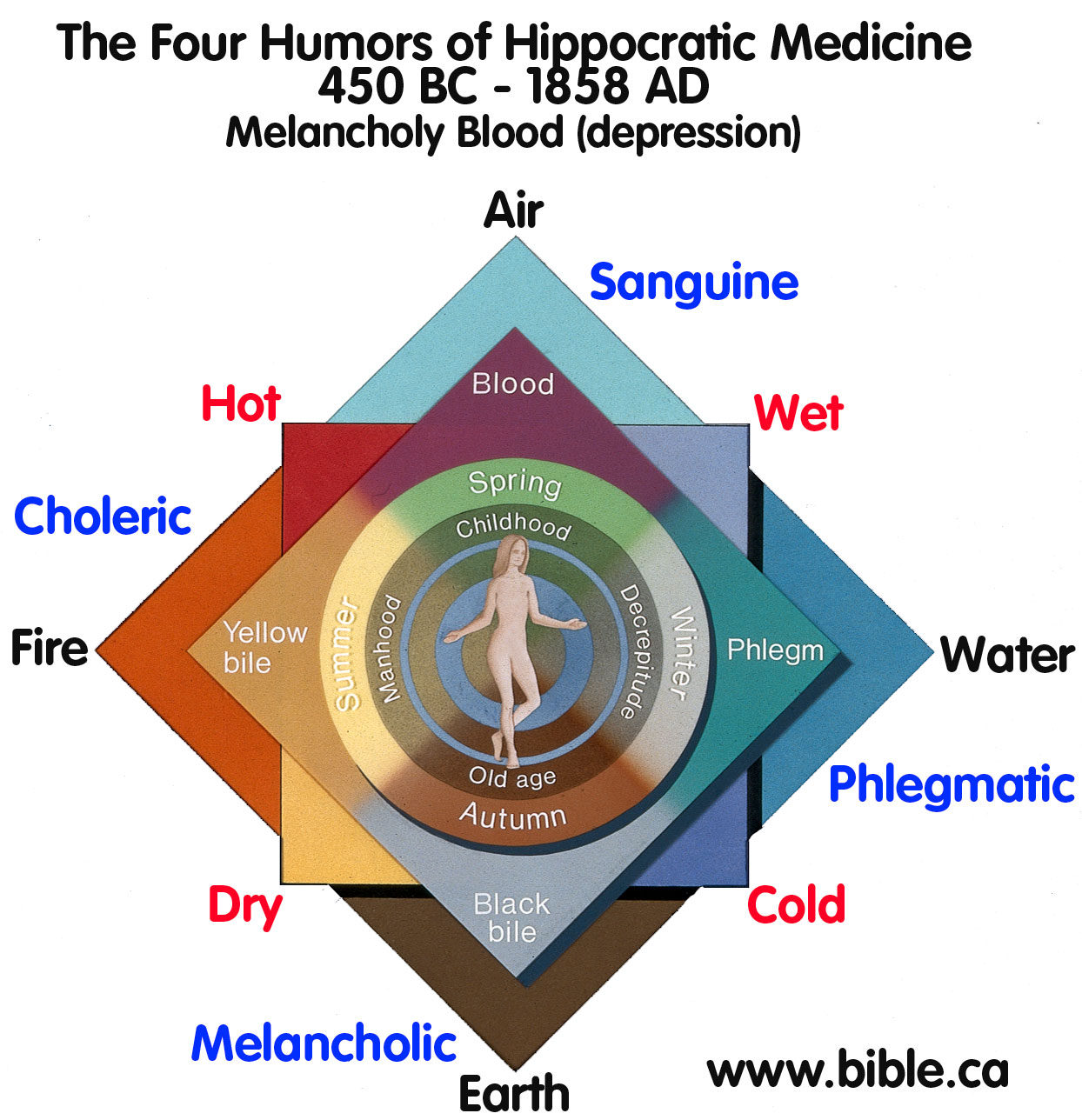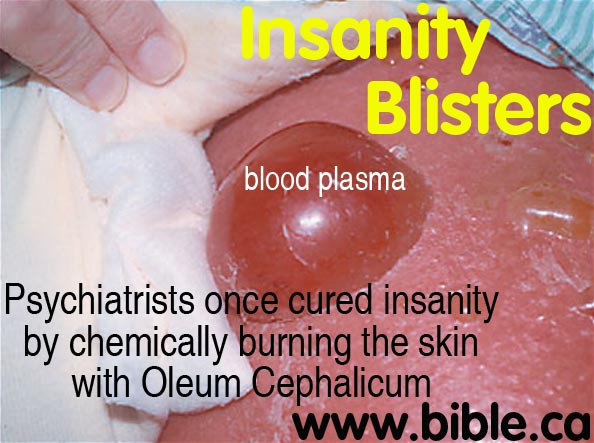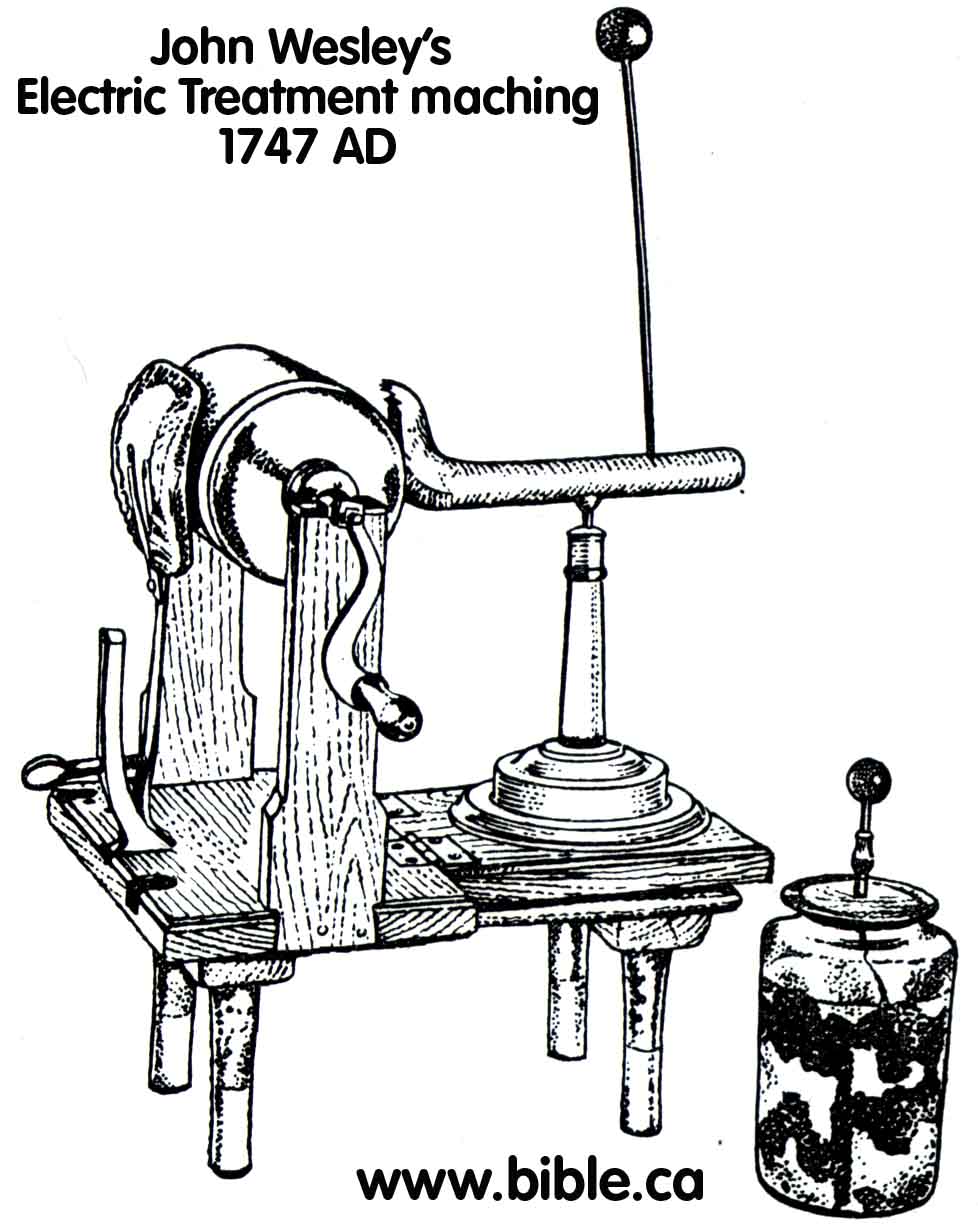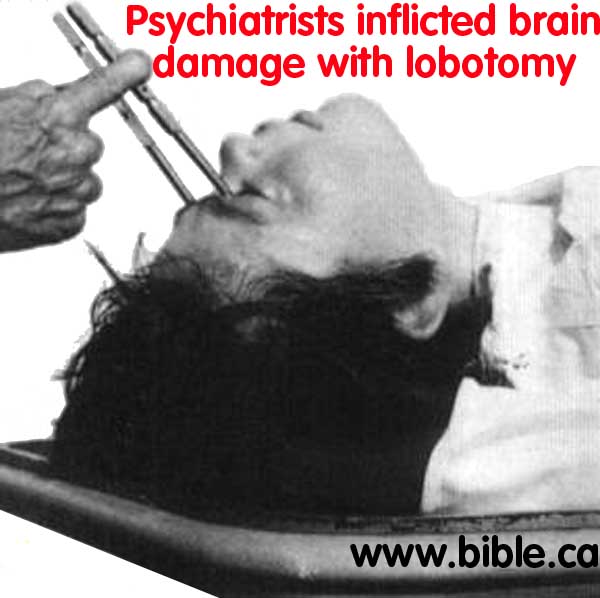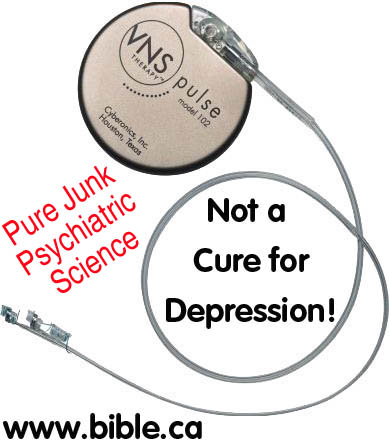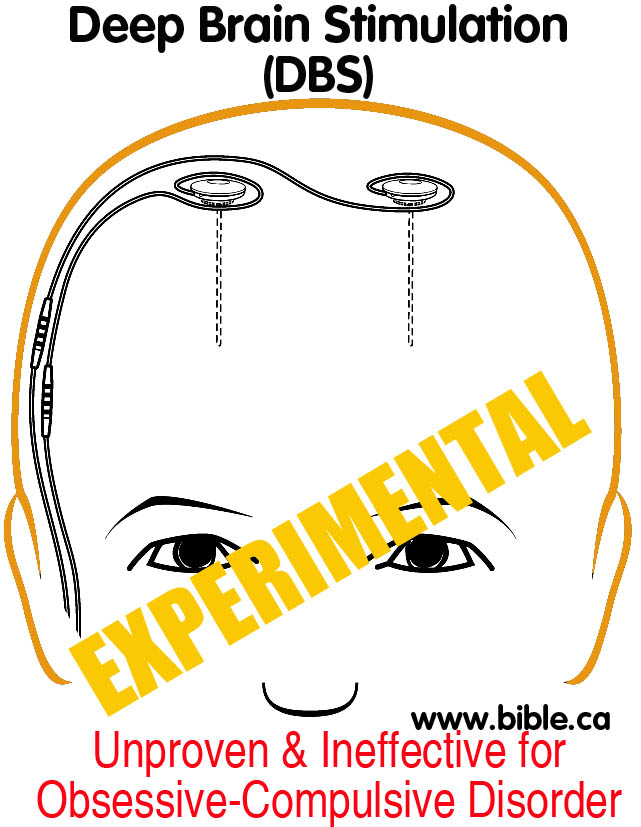Historic
Psychiatric treatments for mental illness
![]() See also: History of Psychiatry homepage
See also: History of Psychiatry homepage
|
|
|
|
Society
has methods of teaching you to behave: |
|
|
|
|
![]() See also: History of Psychiatry homepage
See also: History of Psychiatry homepage
![]() Introduction to psychiatric history
Introduction to psychiatric history
![]() Historical Survey
of Mental illness etiology 1500 - 1900
Historical Survey
of Mental illness etiology 1500 - 1900
|
|
|
|
see also: |
|
|
see also: |
|
Introduction:
- Insanity has always been characterized by the sins of anger, selfishness, rebellion, laziness, violence, assaults, lack of obedience and all the other things young children get spanked for by their mothers. When mother fails, its on to the judge and jailer. When all else fails, its off to the asylum, where they will finish what your mother started. Basically society provides three methods of teaching you to behave through spankings and time out: 1. your mother 2. the police 3. the asylum. 4. the church. Although this is a historic review of the past, nothing has really changed much even today in psychiatry. The modern methods are simply sanitized versions of what you will see practiced historically.
- These treatments were all methods of controlling, confining, punishing and forcing compliance with rules and general obedience. "We come next to mention the remedies that are proper to act upon the body through the medium of the mind: absurdity, folly, cruelty, music, terror fear, accompanied with pain, and a sense of shame" (Medical Inquiries and Observations Upon the Diseases of the Mind, Benjamin Rush 1812 AD)
- The insane have always been a problem for the population at large, being disruptive, lazy, unproductive, etc. A "madman" that assaults people in the down town core, runs into moving traffic, seeks attention and revenge against society, screams at people he does not know as they walk by, is a prefect candidate for this kind of treatment. It worked! For example, when someone was screaming in the town square and being verbally abusive and annoying, they brought him to the asylum and shoved the "pear" in his mouth and stuck him in a dark room with a straitjacket. After a few days, he would become obedient and be let out. If he started screaming again, in went the "pear" for a few more days!
- Historically, asylums were clearly used for social control, just as they are today. In the past they used physical means of control. Today they use a chemical means of control: Neuroleptic drugs.
- One key observation is that the mad doctors of from 1700 - 1900 AD, agreed that isolation, incarceration and vomits indeed cured mental illness. It is clear they had no idea why this worked, but they observed that these methods cured mental illness. We believe that isolation, incarceration and vomits really did cure mental illness, but not for reasons they thought. Some other mechanism must be present. The reason seems obvious. Since mental illness has no etiology in the physical body, but is entirely a "spiritual sickness", isolation, incarceration and vomits made the "patients" life so miserable, he cured himself in order to escape! This may appear as bizarre as bloodletting to people today, but this simple answer is correct! The one's that were not cures, were fatalists who had given up on life.
- "The administering of debilitating therapies or substances, while intended to reduce the violence of the frenzy, or to weaken the animal spirits that were producing it, also had the benefit of keeping the mad in their place. A mad individual was much easier to recognise once he or she had been treated for a while-the image of Cruden with his chain and single slipper is accompanied by countless depictions of the lunatic with the shaved head, the plaster or poultice, half naked and wide-eyed-and was far less likely to have the energy for escape." (Patterns of Madness in the Eighteenth Century, A Reader, Allan Ingram, 1998 AD, p 4)
- "How To Treat A Bedlamite: It may well be that, rather than his complicity in putting the inmates on display, what most indicts Monro's record at Bethlem is something else: the singularly unadventurous approach toward the treatment of patients that he and other medical officers continued to practice there for decades. Therapeutics at Bethlem was characterized by relatively uniform purges, vomits, and bleeding, administered seasonally to patients, with the occasional addition of tonics (such as alcohol), cold bathing (or other cooling applications), and warm or hot baths, all of these "heroic" interventions being supplemented by (a mostly "lowering" form of) diet and regimen. This model, whereby repletion in the system was countered by depletion, and vice versa, was founded on an essentially humoral approach to mental diseases. Overlaid since the late seventeenth century by a new, mechanistic brand of Newtonian science, older principles and even types of treatment had in reality changed remarkably little. To be sure, John Monro was skeptical of some conventional treatments: he objected to blistering, for example. This was a form of "counter-irritation" involving the application of a chemical preparation to draw out a blister on the head neck, shoulder, foot, or some other exposed part of the body, normally recommended to draw the peccant fluids and humors to the body's surface." (Undertaker of the mind: John Monro, Jonathan Andrews, Andrew Scull, 2001 AD, p 28)
- "The blood of maniacs is sometimes so lavishly spilled, and with so little discernment, as to render it doubtful whether the patient or his physician has the best claim to the appellation of a madman. This reflection naturally suggests itself upon seeing many a victim of medical presumption, reduced by the depleting system of treatment to a state of extreme debility or absolute idiotism. At the same time, I do not wish to be understood as altogether proscribing the use of the lancet in this formidable disorder. My intention is solely to deprecate its abuse. (A Treatise on Insanity, Philippe Pinel, 1806 AD)
A. Spiritual Means of Curing insanity
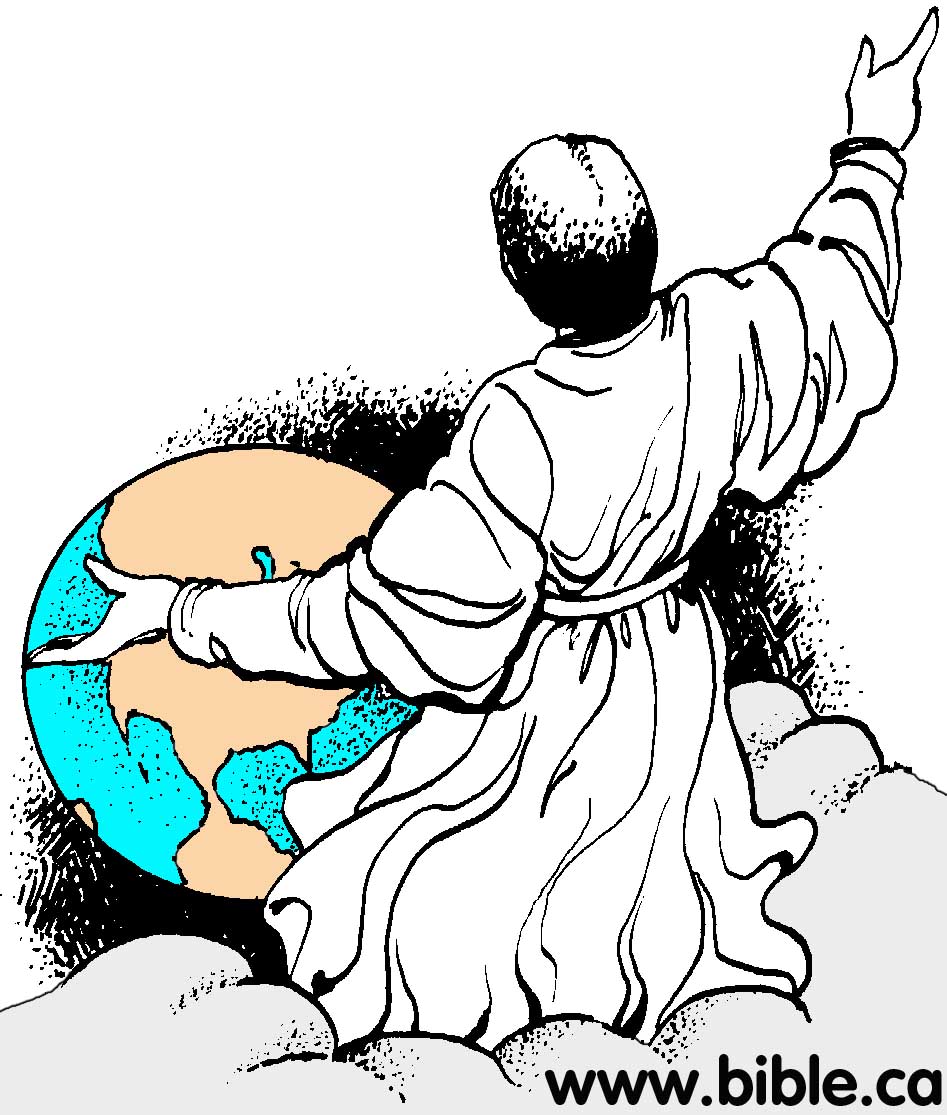
- Historically, looking to Christ to cure insanity has a long history. These cures work today, but this is a collection of statements from antiquity.
- "Methodism was pilloried by its critics throughout this period for its alleged encouragement of "unseemly" forms of worship, spiritual transports, and morbidly pious, agonizing behavior that was often dismissed as "methodical madness," tending toward the incitement of civil and mental unrest."' While Wesley and Whitefield loudly proclaimed that Periam was sane, and had merely been suffering from a spiritual crisis, they castigated James Monro and his colleagues for giving him purges and vomits when what he needed was counsel and guidance." (Undertaker of the mind: John Monro, Jonathan Andrews, Andrew Scull, 2001 AD, p 81)
- Prayer: Cure includes prayer, accepting counsel of others and good diet: "Be most in those Duties which you are best able to bear: Which with most is Prayer with others, Hearing and good Discourse. As a Sick Man whose Stomach is against other Meats, must Eat of that which he can Eat of. And God hath provided variety of Meats, that one may do the Work, when the other are wanting." (The Signs and Causes of Melancholy, Richard Baxter, 1670 AD)
- Attending church weekly: Always be in the company of positive holy Christians (never miss church): "THEY who are not able to be much in solitary Thoughtfulness, without Confusions and distracting suggestions, and hurrying vexatious Thoughts, must set themselves for the most part to those Duties, which are to be done in Company by the help of others; and must be very little in solitary Duties ... AVOID all unnecessary Solitariness, and he as much as possible in honest cheerful Company. You have need of others, and are not sufficient for your selves: And God will use and honour others as his hands, to deliver us his Blessings. ... But keep Company with the more cheerful Sort of the Godly. There is no Mirth [gladness] like the Mirth of Believers, which Faith doth fetch from the Blood of Christ, and from the promises of the Word, and from experience of Mercy, and from the serious fore-apprehensions of our Everlasting Blessedness. Converse with Men of strongest Faith, that have this heavenly Mirth, and can speak experimentally of the Joy of the Holy Ghost; and these will be a great Help to the reviving of your Spirits, and changing your Melancholy Habit so far as without a Physician it may be expected." (The Signs and Causes of Melancholy, Richard Baxter, 1670 AD)
- Learning your problems are common: Your difficulties are very common, suck it up! Christians are your example: "Yet sometimes it may not be amiss to confer with some that are in your own Case, that you may see that your Condition is not singular. For Melancholy People in such Distresses are ready to think, that never any was in the Case that they are in, or at least never any that were truly godly: When you hear People of the most upright Lives, and that truly fear God, to have the same complaints as you have your selves, it may give you hopes that it is not so bad as you before did imagine." (The Signs and Causes of Melancholy, Richard Baxter, 1670 AD)
- Focusing on the positive: The Bible makes it clear that the Christian must not dwell on their own personal problems and hardships but on the positive! "Finally, brethren, whatever is true, whatever is honorable, whatever is right, whatever is pure, whatever is lovely, whatever is of good repute, if there is any excellence and if anything worthy of praise, dwell on these things. The things you have learned and received and heard and seen in me, practice these things, and the God of peace will be with you." Philippians 4:8-9 Put negative thoughts our and dwell on the positive! "WHEN Blasphemous or disturbing Thoughts look in or fruitless Musings; presently meet them, and use that Authority of Reason, which is left you to cast them and command them out. If you have not lost it, Reason and the Will have a command over the Thoughts, as well as over the Tongue, or Hands or Feet. And as you would be ashamed to run up and down, or fight with your Hands and say, I cannot help it: So should you be ashamed to let your Thoughts run at random or on hurtful Things, and say I cannot help it: Do you do the best you can to help it? Cannot you bid them be gone? Cannot you turn your Thoughts to something else? Or cannot you rouze up your self and shake them off? Some by casting a little cold Water in their own Faces, or bidding another do it, can rouze them from Melancholy musings as from Sleep." (The Signs and Causes of Melancholy, Richard Baxter, 1670 AD)
- Christ cures! Depression is the price atheists pay for rejecting God. This is the only cure for depression without faith in God! There is no hope of a cure from mental illness for non-Christians. Historically and today, society will not intervene in a person's delusions unless they begin to interfere in their own every day duties or others. Society is full of delusional atheists who believe we evolved from monkeys, reject the existence of God and the Devil, and the coming judgement day at the second coming of Christ. Atheists by definition are mentally ill since they believe mythical things to be true and reject things that really do exist. But as long as they can hold down a job and keep their lawns cut and not interfere with their neighbour, we don't step in and commit them to mental hospitals. When the atheist becomes depressed or "melancholic" because they comprehend the futility of their very existence it begins to affect their job performance, sick leave, inability to function in a social setting like a family, then the "mad doctors" are called. They offer no solution, but do prescribe Neuroleptic drugs that will artificially and chemically zap them out of their melancholic inactivity like 10 cups of coffee. The depression is caused by the religious views of the atheist that he is merely a product of random chance processes with no purpose or meaning in life. Drugs do not change one's belief system, but the Bible says, "faith comes by reading the word of God". Depression is only as incurable as the person is unable to pick up a Bible and start believing in God. Suddenly new life and meaning flashes into the darkened soul of the lost sinner who begins to believe he was created by a God who not only loves him, but watches out for him and has an exciting future in store for him in heaven forever! This is the only cure for depression. Depression is the price atheists pay for rejecting God. The Bible says that that unbelievers hurt themselves with no cure except turning to God! "receiving in their own persons the due penalty of their error" Rom 1:27 Those who "have wandered away from the faith and pierced themselves with many griefs." 1 Tim 6:10 "suffering wrong as the wages of doing wrong" 2 Peter 2:13 "Otherwise they might see with their eyes, Hear with their ears, Understand with their hearts, And return and I would heal them." Isa 6:10 "DO not misunderstand me: In Cases of absolute necessity, I say again, you must strive to do it, what ever come of it. If you are backward to believe, to repent, to love God and your Neighbour, to live soberly, righteously and godly, to pray at all; here you must strive, and not excuse it by any Backwardness; for it is that which must needs be done, or you are lost." (The Signs and Causes of Melancholy, Richard Baxter, 1670 AD)
- Reject the cures and solutions of non-Christians: Do not get drunk, listen to the world's advice or cheer yourself up with sex and partying. "NOT that I would have you as the foolish Sinners of the World do, to drink away Melancholy, and keep Company with sensual vain and unprofitable Persons, that will draw you deeper into Sin, and so make your Wound greater instead of Healing it, and multiply your Troubles when you are forced to look back on your sinful loss of Time." (The Signs and Causes of Melancholy, Richard Baxter, 1670 AD)
B. Means of Restraint and punishment
"A special building must be set aside for the physical treatment of the mentally disturbed. This building should have a special bathing section, with all kinds of baths, showers, douches, and immersion vessels. It must also have a special correction and punishment room with all the necessary equipment, including the Cox swing (or, better, rotating machine), Reil's fly-wheel, pulleys, punishment chair, Langermann's cell, etc." (Textbook of Disturbances of Mental Life and Soul, Johann Heinroth, 1818 AD)
"Spinning in chairs, rotating in swings, prolonged immersion beneath high pressure cold showers, surprise plunges into icy water, or lying in warm baths while cold water was applied to the head, were all methods calculated to debilitate, shock, and soothe sanity back into the system. The rotary treatment was apparently applied more as a corrective, than a therapeutic treatment. "After having committed some irrational and spiteful act, the patient is forthwith placed on the rotating chair and revolved at adjusted speed until he becomes quiet, apologizes, and promises improvement, or until he starts to vomit." (Cox's Chair, Nicholas J. Wade, 2005 AD, p. 77)
Physical means of restraint and punishment
- Water treatments:
Douche, Dripping, dunking, waterboarding:
Case 1: Patrick Blair, 1725 AD, Doctor, perfected a system of torture that cured the insane that he learned of from Franciscus Helmont in 1694. He cured a woman who was, "mad, neglected every thing, ... kept her room, would converse with nobody but kept spitting continually" and refused to have sex with her husband. For 7 weeks before water treatment, she had "frequent bleedings, violent Emeticks, strong purgatives and potent Sudorificks and Narcoticks were not wanting". This brought about a partial cure: "gave all signs of recovery except that of the dislike to her husband". She he strapped her naked into the chair which, "put her in an unexpressable terrour especially when the water was let down. I kept her under the fall 30 minutes, stopping the pipe now and then and enquiring whether she would take to her husband but she still obstinately deny'd till at last being much fatigu'd with the pressure of the water she promised she would do what I desired". But the next day she refused. So he water tortured her in this way two more times. But when she recovered, again she refused. So Blair, "I threatned her with the fourth Tryal, took her out of bed, had her stript, blindfolded and ready to be put in the Chair, when being terrify'd with what she was to undergo she kneeled submissively that I would spare her and she would become a Loving obedient and dutiful Wife for ever thereafter. I granted her request provided she would go to bed with her husband that night, which she did with great chearfullness ... About 1 month afterwards I went to pay her a visit, saw every thing in good order". Blair proclaimed her cured! Whether you view this as a genuinely insane woman or a stubborn angry wife putting on the act of a mad man, either way it corrected the bad behavior! Blair claimed his water treatment by the "fall of water" was, "the safest method of curing mad people ... and sink the patients spirits even to a deliquium [melted] without the least hazard of their Lives."
Case 2: Alexandre Boismont 1859 AD: "Will you go and work to-day ?" "Since you compel me, I must go." "Do you go willingly?" "I will go, because you compel me." "You ought to say, that you perceive it is to your advantage to go and work. Will you go willingly, yes or no ?" (Hesitated-the douche.) After a short interval: " Yes, sir, all I have said to you is nonsense; I will go and work." " Have you been insane ?" " No, I have not been insane." " Have you not been insane?" " At least I believe not." (Douche.) " Have you been insane?" "Am I mad because I have had imaginations, because I have seen and heard it?"
Case 3: In 1828 AD, Sir Alexander Morison, Doctor, illustrated two torture machines widely used between 1725 AD and 1850 AD to cure the insane: Water treatment and the Swing. The fact they were so widely used and indeed cured the insane, is historic proof that mental illness is not a bodily disease or chemical imbalance in the brain, but a spiritual choice made by the "patient". (Cases of Mental Disease, with Practical Observations, Sir Alexander Morison, 1828 AD)
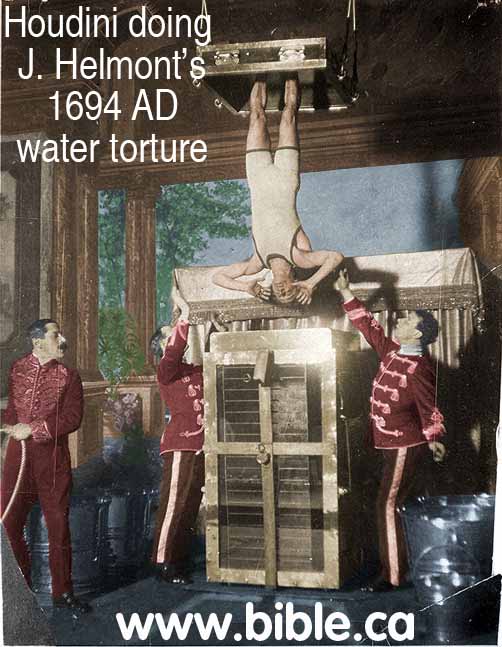



- Cox's swing or swing machine
In 1811 AD, Joseph
Mason Cox, cured the insane called "the swing" which spun an
insane, uncontrollable and obstinate person in a straitjacket until motion
sickness, vomiting, unconsciousness and shock set in. When they began
begging to get out of the machine, they would be asked if they would obey
orders. The person would then be put to bed and sleep until they
recovered. Often the person would become obstinate again and they would be
put back in the swing again only to repeat the process until full
compliance was attained. "for which the original idea must be
attributed to the famous Darwin. An ordinary chair is suspended in the air
from a hook fastened in the ceiling by means of ropes tied to its legs,
and is set into circular motion by rotation. Alternatively, the apparatus
may be set up according to Darwin. A pole is fixed between floor and
ceiling by iron rods, so that it can execute a very rapid rotary motion.
It is fitted with a horizontal arm, by which it is set in motion, and from
which a small bedstead may conveniently be suspended. Or else a chair with
the patient tied to it is affixed to the pole, and the pole is set in
motion with the aid of a rope wound around it, in the same way as a top.
(Reil, Beytriige, Vol. I, p. 617). Dr. Horn was the first to introduce the
swing machine into Germany, and he considerably improved its design. We
are awaiting his report on the subject, to which the reader is referred.
... Cox's swing machine, which was introduced in Germany in 1807 by Horn,
who markedly improved its design and renamed it "threshing machine."
Sandtmann has given a detailed description of this machine (p. 102).
Contraindications to the use of this machine are rare; it must be
cautiously employed if the patient has a tendency to congestions. In
general, the number and frequency of the swings must be adapted to the
organic individuality. He describes (pp. 104 ff.) its symptoms and
results: vertigo, fear, paleness, anxiety, nausea, vomiting, bowel
movement. The powerful shock to the disposition subdues even the most
refractory patients. Further results are tiredness, sleepiness, and a deep
gentle sleep, which often lasts for many hours. According to Cox, reason
often returns on awakening, and the patient becomes more receptive to
other treatments." (Textbook
of Disturbances of Mental Life and Soul, Johann Heinroth, 1818 AD)
Case 1: Citing a specific case, Joseph Mason Cox says of an insane man who had experienced the swing and promised to change. The next morning... "all his promises were forgotten ... next day the swing was repeated as before ... entreated to be relieved, and repeated his former promise ... [next day] his former mental peculiarities soon after returning, the swing was prepared, and the necessary steps taken for its employment, but rather than repeat the ride in the whirligig, as he termed it, he submitted entirely to my wishes, and, with some occasional returns of obstinacy and disinclination to persist in the remedies I prescribed, I had the pleasure to see him gradually improve till he advanced to perfect reason."
Case 2: Another case of an insane melancholy, lethargic man (inanimate lump) put in the swing: "I was determined to try the effects of the circulating swing as a last resource, into which he was placed as an inanimate lump, with his eyes shut; after a few circumvolutions one eye was observed to be occasionally opened, and at length both, a degree of alarm seemed next excited, then nausea, and retching to vomit; the motion was then suspended, and he was consulted as to his unwillingness to comply with my requisitions, but he still refusing, the gyrations were renewed, when the former effects were soon obvious, and the motion being increased, full vomiting ensued; he now begged to be liberated, and promised compliance with my wishes; he was taken out, put to bed, and slept for some hours, when food was offered, but, as usual, refused; he was reminded of his promise, and threatened with an immediate repetition of the swing; this succeeded, and for some days the prognosis seemed more favourable, but the reluctance to eating returned, and recourse was again had to the swing, two or three times, with the former success, till at length he yielded entirely to my wishes, and by very simple management, both mind and body were at length perfectly restored, and I have the pleasure of knowing that he continues well, and I am confident owes his life and reason to the swing."
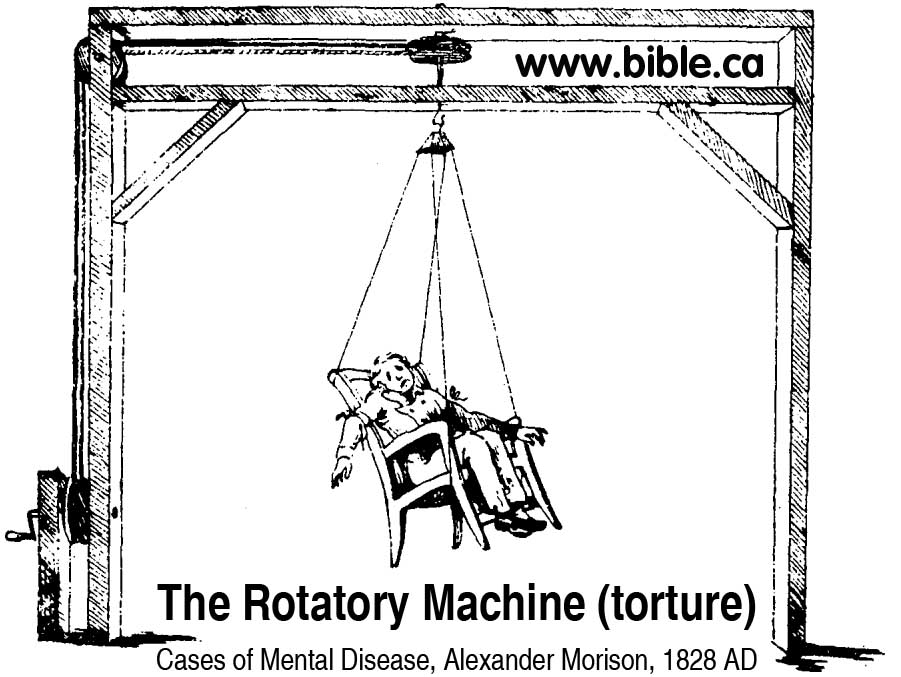
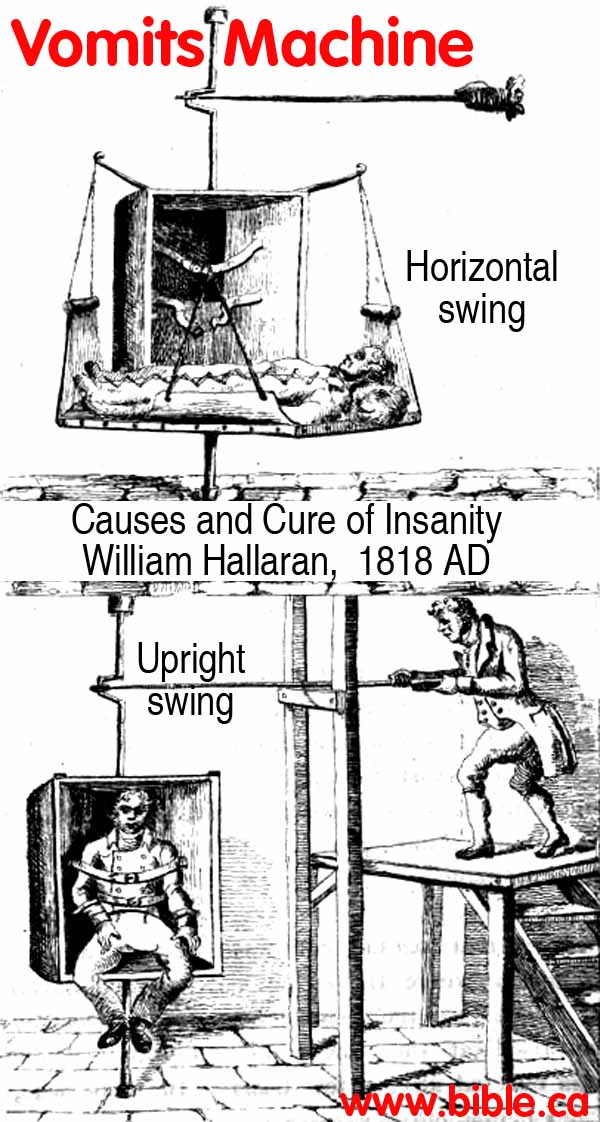
- Autenrieth's chamber,
"which should in fact be called a large cage, as it is designed in
this form. Its purpose is to ensure that the raving patient does not flee
or injure himself or others, while he is still able to move freely. For a
detailed description of this device the reader is referred to Autenrieth
himself (Autenrieth's Versuclze fur pract. Heilk.,Vol. 1, No. I, p. 212),
and to Hainer in the pamphlet already mentioned. We find ourselves unable
to recommend it in any way, for the following reasons. Firstly, use of the
contrivance precludes any curative achievement; for if the patient is
allowed to rage as much as he likes and move about within the space
allotted to him, he remains master of himself and acts according to his
own will. Now it is precisely this will which is bad and which must be
restrained, since the whole power, the whole form of the disease is
concentrated in it. Autenrieth's chamber thus prevents all medical
influence on the patient. Secondly, even if our only purpose is the safety
of the patient, who must be prevented from inflicting injury on himself,
it must be remembered that the patient can ram his head against the wooden
bars of his cage just as effectively as against a stone wall. For such
patients often tend to butt their heads against obstacles. Finally, since
in any hospital or asylum, which very rarely contains fewer than a
hundred, or often some three hundred, mentally disturbed of all kinds,
there are almost always a few candidates for Autenrieth's chamber, or,
since it may happen that several such patients qualify for the chamber on
the same day, are we to lock them all together in the chamber, since all
are to receive the same care and treatment? And if we do not wish to do
this, how many such chambers must we build for each institution, and at
what cost? We must therefore repeat our former conclusion: the proper
place for such patients is the confining chair. Here their rage will be
spent in a short time, or rather, since they are prevented from violent
gesticulation, hitting out, stamping, etc., and if possible also from
screaming and cursing, they come to their senses much sooner. Half a dozen
such chairs are still cheaper than a single Autenrieth's chamber. The
author has often seen great improvements brought about by the confining
chair but has never witnessed the slightest harm. If this device proves to
be of no use, and the patient should break all bounds (literally
speaking), we still have the swing machine." (Textbook
of Disturbances of Mental Life and Soul, Johann Heinroth, 1818 AD)
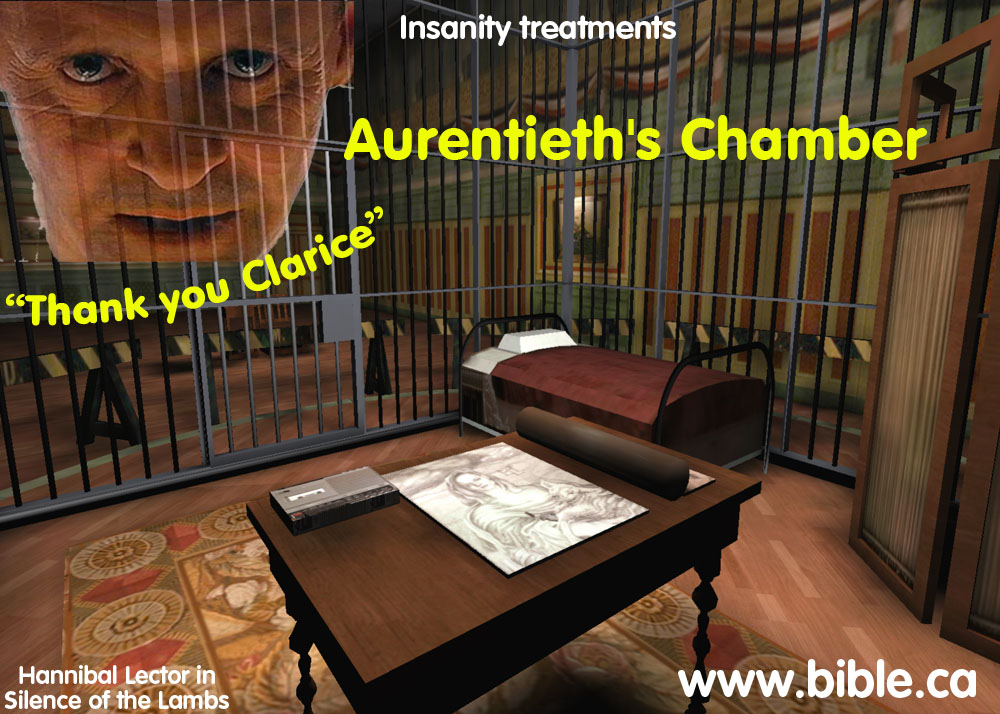
- The Clock.
"This device resembles the casing of a grandfather clock, such as may
still be found in the halls or rooms of old families. It is as tall as a
man, and it has an empty space in the place of the clock face. The head of
the patient is put inside, and his face is then displayed in place of the
dial. The patient is thus rendered ridiculous, which is the purpose of the
device. The mentally disturbed, who are usually quiet and are able to
experience pride and shame, are punished in this way for infractions of
rules that they were told to obey. However, discrimination must be
exercised in the application of this punishment, since such restraint, the
main purpose of which is to put the patient to ridicule, can embitter him
just as easily as make him mend his ways." (Textbook
of Disturbances of Mental Life and Soul, Johann Heinroth, 1818 AD)
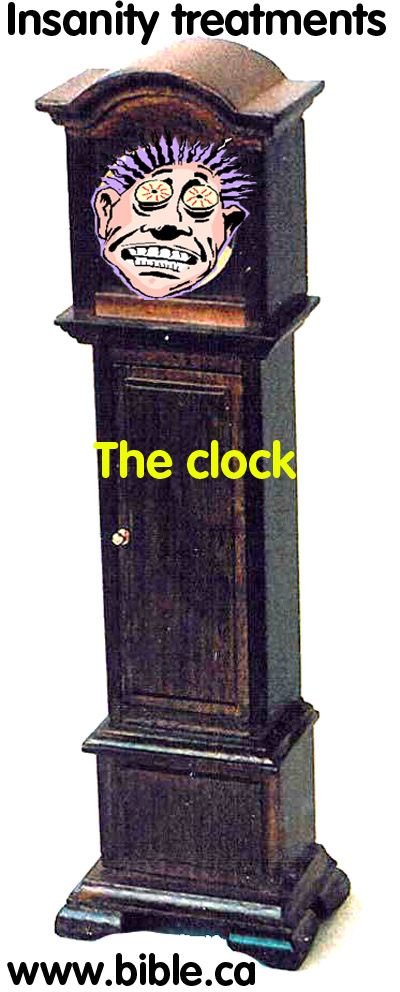
- English Coffin:
Similar to the "Clock" it was a box with a hole cut out used in
England and in North america.
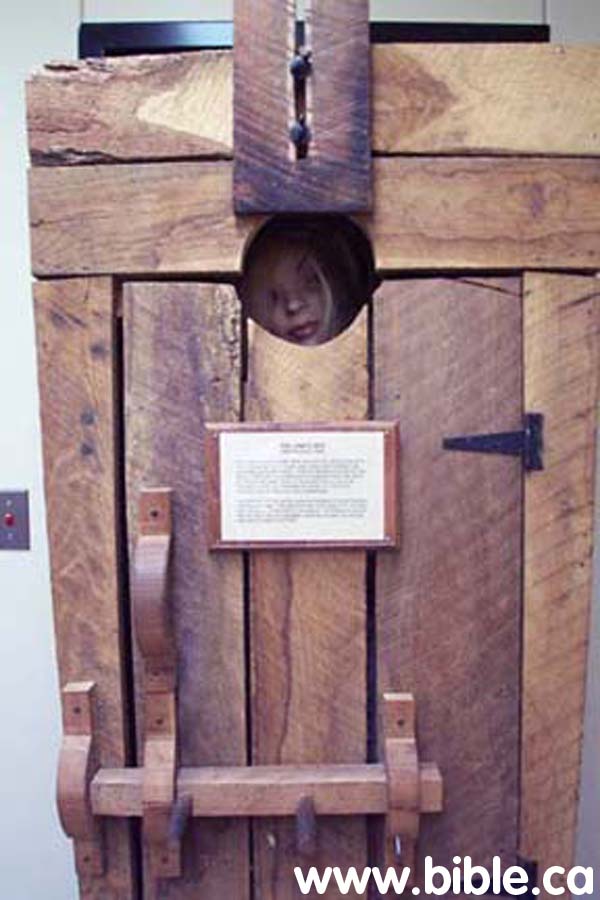
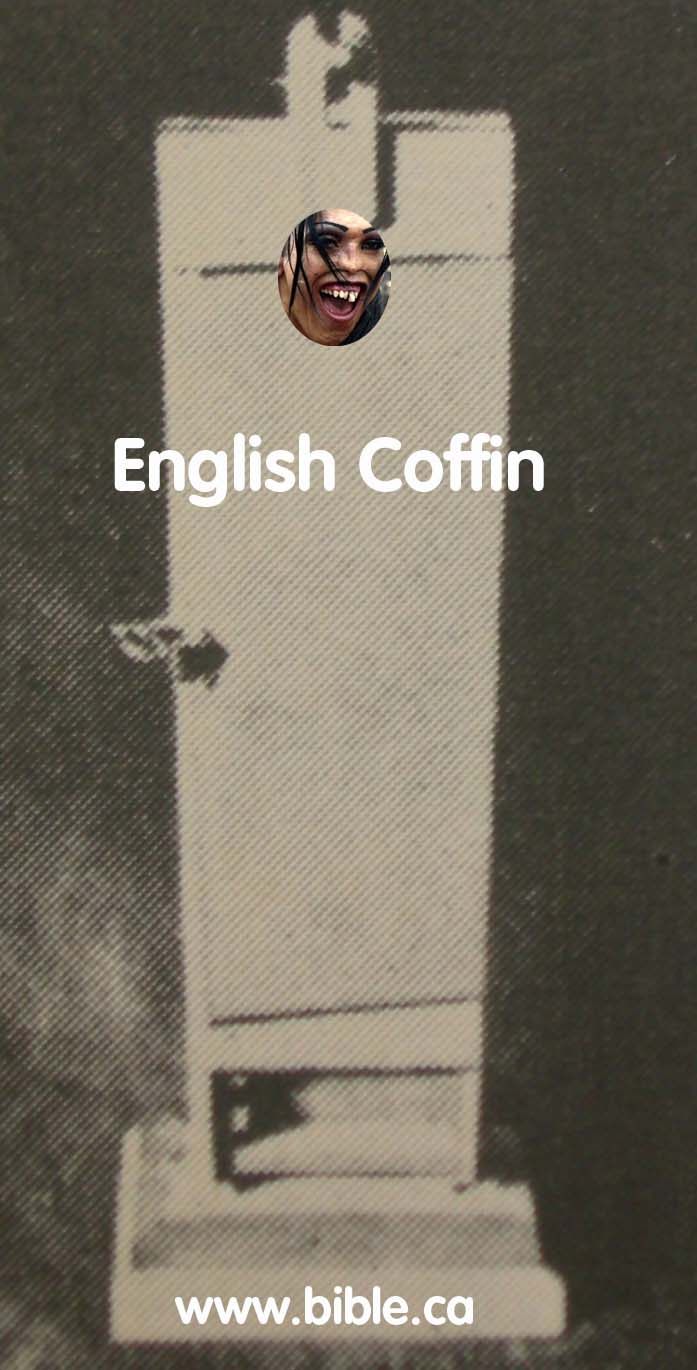
- The sack. "An
ordinary sack made of ordinary material, with a length and circumference
suited to the height and girth of the patient, fitted with straps at its
open end, and completely or partly covered with wax cloth to prevent the entry
of light. Experience has shown that the patient in the sack is in danger
of asphyxiation and of falling victim to convulsions. For a detailed
description of this device, see Sandtmann's publication, which has already
been quoted on several occasions." (Textbook
of Disturbances of Mental Life and Soul, Johann Heinroth, 1818 AD)
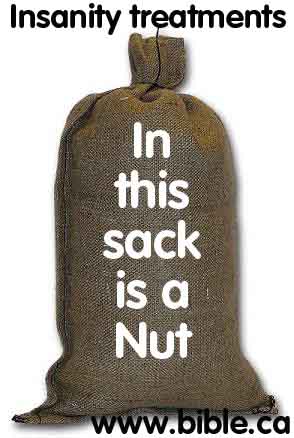
- The Box:
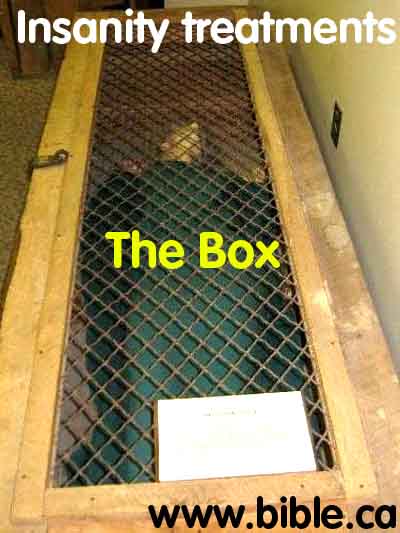
- The Crib
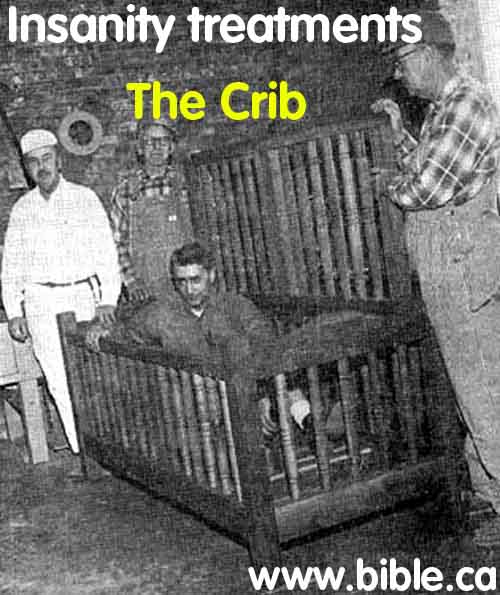
- The Wheel: German
psychiatrist Johann Reil (1758-1813) invented a hollow wheel as a form of
restraint, control and exercise for up to 36 hours, often to the amusement
of the mad house keepers. Fellow German psychiatrist, Johann Heinroth
recommended every asylum have one!
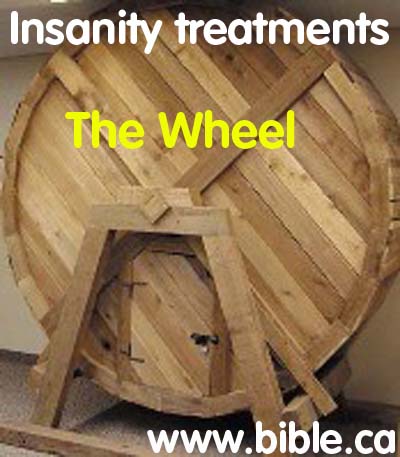
- Straitjacket. "The straitjacket is a well-known English invention. It is a jacket made of a strong material, which is closed at the front, while at the back it is open and has straps which can be buckled and sleeves which are so long that when the patient wearing the jacket crosses his arms over his chest, the sleeves can easily be passed round his back and again to the front and there be bound together with the broad straps fitted at their closed ends. Similar kinds of long trousers may also be slipped over the patient: they are in the form of a sack with a dividing wall and prevent the patient from escaping just as effectively as the straitjacket prevents him from injuring himself or others with his hands. It is undoubtedly one of the best inventions which can be used to restrain the patient without binding him and without injuring him, in any way. The same is not true of the means of restraint which will now be described." (Textbook of Disturbances of Mental Life and Soul, Johann Heinroth, 1818 AD)
- Confining belt.
"A wide, well-upholstered belt made of strong leather which is passed
around the body. The belt is fitted with loops through which straps are passed
to attach the patient to his bed or to another piece of furniture. Both
sides of the belt have open, wide straps with soft lining and with buckles
to tie the patient's hands. The feet are bound in a similar manner in a
double harness with a dividing wall. This harness also has loops to fasten
the lower part of the body to the bed, etc., as well. The bedstead to
which the patient is strapped must have an opening in the middle to catch
the excrements in a vessel put underneath the bed, but the bed of the
patient must consist of a well-upholstered mattress and a well-stuffed
pillow. The patient should be covered with a woolen blanket. Since all
patients who have to be restrained in this manner are less quiet in a
horizontal than in an upright position, this arrangement is much less
suitable than the former." (Textbook
of Disturbances of Mental Life and Soul, Johann Heinroth, 1818 AD)
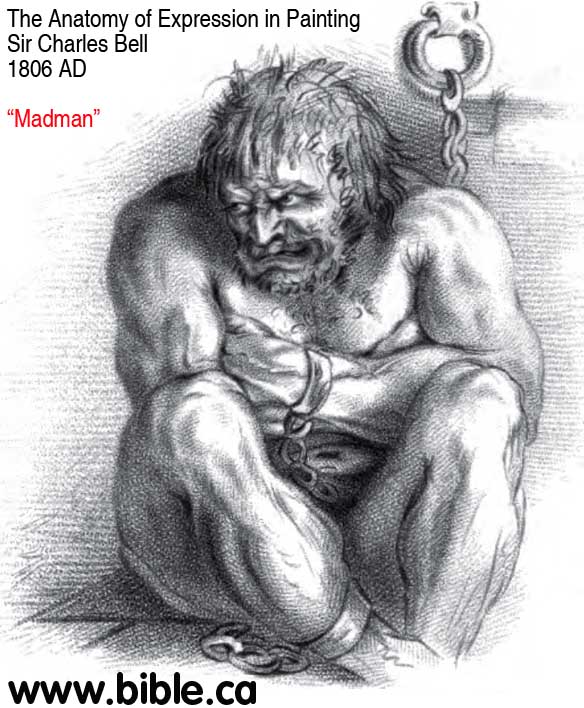

- Chains, leg locks, handcuffs: "The steward's accounts (which, for example, record purchases such as "4 Doz[e]n of Men & Womens Leg Locks" at £6 6s., in 1765,108 and a further dozen leg locks and an extra dozen handcuffs less than two years later), suggest the pervasive extent of mechanical restraint at Bethlem. It was the apothecary (1772-95) John Gozna (d. 1795), rather than Monro, who appears to have introduced strait waistcoats into the hospital very soon after his appointment, in preference to chains, although the latter were never fully dispensed with." Nonetheless, this was an age before the fashionable nineteenth-century doctrine of non-restraint had been heard of, and it would be anachronistic to criticize Monro or any others at Bethlem too harshly for the apparent lack of interest they took in methods that were relatively universally employed in the treatment of the insane, at least before John Monro's death in the 1790s-techniques that these practitioners must have regarded as pragmatic and essential tools for the control and disciplining of unruly patients." (Undertaker of the mind: John Monro, Jonathan Andrews, Andrew Scull, 2001 AD, p 33)
- Confining chair.
"This is an armchair, which may be of different breadth or height, is
comfortable to sit in, well-upholstered at the back, the sides, and the
seat, lined with leather, with wide arm rests and strong legs which can be
screwed to the floor. The seat has an opening for the buttocks of the
patient. The back of the chair has straps for the neck, the chest and the
body. The sides of the chair have straps with a soft lining for the thighs
and feet. These must be applied so that no undue pressure is exerted on
the patient. A footstool about 6-8 inches high is also provided so that
the feet of the patient do not hang down. Here again the feet can be held
down with straps. It is not at all easy to bind the patient so as not to
cause him pain and at the same time make it impossible for him to slip
out. It is well known that such patients are very strong and very supple,
and very precise skill is required to restrain them without doing them any
harm. Hence, the large number of well-padded straps. Extensive
observations made by the author led him to the conclusion that the chair
is completely harmless; the patient can remain
bound in the chair for weeks on end without incurring the slightest bodily
harm. If the straps are not properly adjusted, edema may appear on
one or other hand after a few days, but disappears within 24 hours after
the patient has left the chair. In any case, after
a few days, the patient usually becomes submissive enough to be let loose.
The author has repeatedly observed that men and women, who could not
otherwise be handled, became mild and submissive, and even came to their
senses after being left bound to a chair in a dark, lonely place. He
therefore cannot agree with those who find this treatment harsh and cruel.
If indeed some patients cannot be cured without being restrained, and
without being restrained to a severe degree, then the author believes that
this kind of restraint is by far the best and is most wholeheartedly to be
recommended. For to bind the patient with the constraining belt alone,
while allowing him to move freely otherwise, is only a half-measure. The
straps by which the patient is bound to the bedstead do not eliminate the
disadvantages of the horizontal position; also, since the arms and legs
are held at only one point, the limbs are free to move just enough to
produce skin abrasions at these points, or possibly to slip out of the
bonds, and this can only be prevented by making the straps tighter. Thus,
a severe edema soon appears; the limbs become cold; the abraded sites of
the limbs bleed and become inflamed, and ulcers form. The author noted
that even this mistake occasionally had beneficial effects, since the pain
and the bandage made the patient take notice; but it must not be
recommended on this account. However much we may praise the straitjacket,
we must note, first, that patients who display very wild behavior can soon
slip out of it, and, second, it does not fulfil the true purpose of
restraint, because the patient does not feel at all restrained by it,
since he can walk about quite freely. This again is only a half-measure.
The sack, admittedly, gives the fullest restraint, and does so in the most
painful manner; but it is unsuitable because of the danger of
asphyxiation, an epileptic fit, or apoplexy (and not because of the fear
and pain caused to the patient: for both are means of healing; thus,
surgical operations are also pain-ful, but must be carried out all the
same). This danger of apoplexy, as well as the danger of lethal
hemorrhages, is also a very grave objection to the medic-ament to be
described next and which is strongly recommended by Cox." (Textbook
of Disturbances of Mental Life and Soul, Johann Heinroth, 1818 AD)
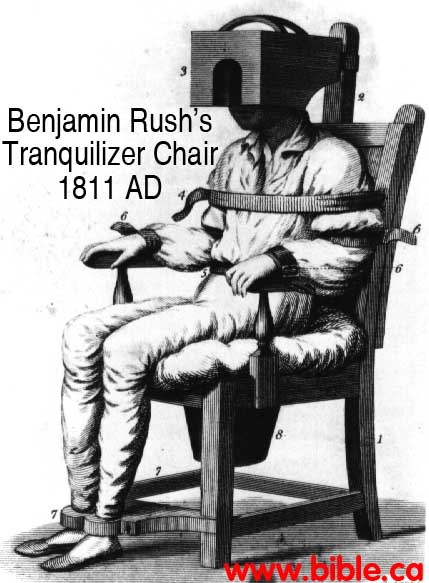
- Aurentieth's mask.
"A mask-like device, by means of which screaming and roaring of the
raving patient are rendered more difficult, but by no means impossible. It
must be considerably improved, or rather its design should be altered so
that the patient is prevented from opening his mouth, while able to
breathe freely through the nose." (Textbook
of Disturbances of Mental Life and Soul, Johann Heinroth, 1818 AD)

- The pear. "A
piece of hard wood, with the shape and dimensions of a medium-sized pear,
has a crossbar fitted with straps which can be tied at the back of the neck
of the patient. Since the oral cavity of the patient is more or less
filled by this instrument, the patient can obviously utter no articulate
sounds, but he can still utter stifled screams, which is the more
undesirable as the patient has to make a greater effort to do so; except
that he might grow tired of this effort and become quiet. This is actually
the purpose of this device, which must not be condemned as cruel, since
its aim is to produce one of the most healing restrictions. Just as badly
brought up children, or rather spoiled children, give vent to their malice
through screaming and thus enjoy themselves, so unruly patients give vent
to their rage and obstreperousness by screaming and roaring if they cannot
do so in any other manner, and tend to scream more the more they are
forbidden to do so. If they are prevented from screaming, they lose their
only remaining weapon (since they are restrained) and must finally
acknowledge their total impotence. Nevertheless, an efficient muzzle,
which would not have the disadvantages of the mask and of the pear, has
not yet been invented." (Textbook
of Disturbances of Mental Life and Soul, Johann Heinroth, 1818 AD)

- Lacing. "This simple procedure, which is the last one to be mentioned, is especially suitable for mentally disturbed female patients who need restraining not so much on account of their wild behavior but because they display morbid stubbornness and refractoriness, and because of their perverted actions, and who would only laugh at mere confinement in a straitjacket. Such patients are first confined in a straitjacket, laid on their bed, covered with a blanket, and laced to the bed with ropes applied over the blanket, just as ropes are drawn over babies' cradles or as women are wont to lace their corsets. Thus, the same procedure serves for both confinement and punishment, since the patient very strongly objects to being treated like a child. After a few hours the patient begs for his freedom, and the author has seen very satisfactory results obtained by this treatment." (Textbook of Disturbances of Mental Life and Soul, Johann Heinroth, 1818 AD)
- Corporal Punishment:
"However objectionable this may appear to some people, corporal
punishments such as slaps in the face, birching
[whipping with a birch stick] of the posterior. But these punishments must
be administered in the presence and on the instructions of the doctor,
since they must be applied with caution. The author has seen very
satisfactory results yielded by these remedies, which are often the only
ones which make any psychological impression on the patient. Thus, after
due warning, he administered a sharp slap in the
face to a mad woman who kept abusing him and others whom she wanted
to impress by her pretended superiority. The result was that not only was
the woman brought back within the bounds of good mariners, but that he
gained so much domination and influence over her from that moment on, that
she willingly submitted to all his instructions. After her recovery,
although she had not forgotten anything that had happened to her during
her sickness, she never showed any ill will towards him, as is often the
case with such patients. Pinel tells of a similar case of a young man, who
had believed himself to be a Swedish prince and had displayed a
correspondingly insolent behavior, but was brought to his senses by an
unexpected box on the ears administered by his (female) nurse. The author
himself has administered strict but cautious birchings to some of his
patients, with similarly satisfactory results." (Textbook
of Disturbances of Mental Life and Soul, Johann Heinroth, 1818 AD)
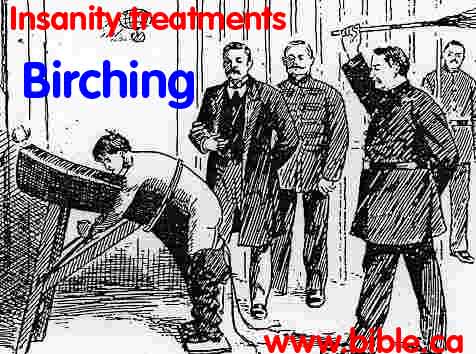
- Cold. "cold baths, the pouring of cold water over the head, or cold compresses (Schmucker's artificial compresses). Cox advises to place a mud cap on the patient; another technique is to let ether evaporate on the shorn scalp of the patient." (Textbook of Disturbances of Mental Life and Soul, Johann Heinroth, 1818 AD)
- Warm Baths: "The power of judicious kindness over this unhappy class
of society, is much greater than is generally imagined."
"The comfort of the patients is therefore
considered of the highest importance, in a curative point of view."
"That this remedy deserves the attention it receives in this
Institution, appears evident by the unusual number of recoveries, in cases
of melancholia, to which class the warm bath is
chiefly applied. In several cases where the use of this means has been
necessarily suspended, the patient has evidently relapsed. No
advantage has been found from its use, in case of mania ; indeed, it has
been thought rather to aggravate the symptoms. The time of the patient's
continuance in the bath, and the temperature at which it is used, are
gradually increased ; the former from twenty minutes to nearly an hour ;
and the latter, from 85 to 98 degrees. The cold bath has been frequently
tried in a variety of cases, both of melancholia and mania ; but the
result of the experiments is said to be unfavourable to its general use.
In one case, during a paroxysm of high ungovernable mania, immersion of the
body, except the head, in the cold bath, for the space of one or two
minutes, appeared essentially useful in quieting the patient ; but the
remedy, in such cases, ought to be applied with great judgment ; and its
application should always be witnessed by the master, or mistress of the
family." (Description
Of The Retreat For Insane, Samuel Tuke, 1813 AD)

- Darkness.
- The silence of the remote place of confinement.
Pharmaceutical means of restraint and punishment
- Nervina. "These reduce the irritability and thus also the excitement by raising the nervous energy; but if applied in excessive amounts, they depress both these factors of nervous activity: Camphor. Musk. Naphthene; Haller's acid; Castoreum; Asafoetida; Valeriana" (Textbook of Disturbances of Mental Life and Soul, Johann Heinroth, 1818 AD)
- Narcotica: "These medicaments depress the sensitivity of the nerves and thus also diminish the resultant irritation by producing temporary paralysis of the nervous energy, provided they are administered in large doses; in small doses their effect is just the opposite: Opium, Atropa belladona, Daiwa Stramonium, Hyosciamus niger; Roborantia: Cinchona bark." (Textbook of Disturbances of Mental Life and Soul, Johann Heinroth, 1818 AD)
- Opium is a natural liquid that comes from poppies
and contains morphine, an opiate alkaloid and codeine. Nicholas Robinson
best describes how Opium is the "wonder drug" to cure all, when
all else fails! Of course he wrongly believed that in part, mental illness
was caused by bad Fibres of the Brain and Nerves. "But of all
Medicines in the Spleen, I know none equal or fit
to compare with that truly noble Drug we call Opium. It's our Refuge in
all Distresses; it gives Ease and Relief in the most torturing Pains, and
when all other remedies fail; ... for by relaxing the Fibres of the
Brain and Nerves, it sets their illachinulae at such a Distance from each
other, as either totally destroys their Sensations, or at least greatly
impairs them; whereupon it comes to pass, that the Perceptions are
intercepted for a while, and a pleasing Stupefaction brought upon all the
Organs, that serve the several Senses, which Phaenomenon we call
Sleep." (A
New System of the Spleen, Nicholas Robinson, 1729 AD)

- "Salivation. I mentioned the manner in which this remedy operated upon the brain, the bowels, and the mind, in treating of the cure of hypochondriac derangement. Too much cannot be said in its favour in general madness. I once advised it in a case of this disease from parturition, in which the patient conceived an aversion from the infant that had been the cause of her suffering. On the day she felt the mercury in her mouth, she asked for her infant, and pressed it to her bosom. From that time she rapidly recovered. It is sometimes difficult to prevail upon patients in this state of madness, or even to compel them, to take mercury in any of the ways in which it is usually administered. In these cases I have succeeded, by sprinkling a few grains of calomel daily upon a piece of bread, and afterwards spreading over it a thin covering of butter." (Medical Inquiries and Observations Upon the Diseases of the Mind, Benjamin Rush 1812 AD)
Drug
induced Nausea, vomiting and diarrhea:

- Vomiting was considered the treatment of choice for 200 years.
- Vomiting cured the insane because it made them feel so sick, they were unable to expend the energy needed to act insane and make them feel so awful that they changed their behaviours in order to escape treatment.
- Nausea was induced with spinning machines, chairs, swings, centrifuges, which made people "sea sick" or motion sickness, or through orally injected drugs that made them throw up.
- John Monro prescribed all the standard humoral treatments of like bloodletting, blistering, cold baths etc. but his treatment of first choice was vomits. Here it is in his own words where he induced vomiting in a man 61 times over 180 days: "the most adequate and constant cure of it is by evacuation ... The evacuation by vomiting is infinitely preferable to any other. ... I lately received from a worthy friend of mine the case of a gentleman, who had laboured under a melancholy for three years; he himself calls it an hypochondriacal, convulsive disorder, from which he was relieved entirely by the use of vomits, and a proper regimen. So very sensible was he of their good effects, that he did not scruple to take sixty-one from the third of October to the second of April following; and for eighteen nights successively one each night; by which means he got rid of a prodigious quantity of phlegm, and obtained a perfect recovery. The first seventeen were composed of one ounce of the yin. ipecacoan. with one grain of emetic tartar, and afterwards he made use of no more than half an ounce of the wine. And those, who are much used to hypochondriacal people, will find them in general less weakened with vomits than purges." (Remarks on Dr Battie's Treatise on Madness, John Monro, 1758 AD)
- "Hellebore, an herb used by the ancient Greeks to cure mental disorders, was specified as being "good for mad and furious men." A preparation known as "spirit of skull" involved mixing wine with moss taken from the skull of an unburied man who had met a violent death. Hot human blood, as well as pulverized human hearts or brains, presumably helped to control "fits." While these prescriptions represented the best known "cures," the nauseating quality of the mixtures suggests that the remedy rather than the illness was the more formidable obstacle to recovery. Vomiting may actually have been helpful, and certainly had powerful psychological effects. In any event, the "cures" reflect the state of medical knowledge in colonial America, a time when physicians and laymen read and used the same medical recipe books." (Treating the mentally ill, Leland V Bell, 1980 AD, p 1-4)
Dietetic means of restraint and punishment
- "Low DIET, consisting wholly of vegetables, and those of the least nutritious nature." (Medical Inquiries and Observations Upon the Diseases of the Mind, Benjamin Rush 1812 AD)
- Hunger and thirst. "Man feels his limitations only in his needs, so that hunger is an effective means of restraint. The same is true, to an even greater extent, of thirst. The objection to this cure is that a patient who has decided to fast unto death cannot be subdued by such means. Even Celsus utilized hunger, not as a radical medicine but as a treatment preliminary to the cure in many cases, or else as punishment, together with fettering and beating. The author, too, often punishes disobedience and bad manners displayed by the mentally disturbed by depriving them of food."(Textbook of Disturbances of Mental Life and Soul, Johann Heinroth, 1818 AD)
- Sleep. This is clearly the mildest and gentlest means of restraint.
Psychological means of restraints and punishment
- "A sudden sense of the ABSURDITY, FOLLY, or CRUELTY of certain actions, produced by conversation, has sometimes cured madness. ... one of its managers he said, " I am a salamander;" " but recollect (said Mr. Coats) all the patients in the hospital are not salamanders ;" that is true, said the maniac, and never afterwards attempted to burn the hospital." (Medical Inquiries and Observations Upon the Diseases of the Mind, Benjamin Rush 1812 AD)
- "Music has been much commended in this state of madness." (Medical Inquiries and Observations Upon the Diseases of the Mind, Benjamin Rush 1812 AD)
- "TERROR acts powerfully upon the body, through the medium of the mind, and should be employed in the cure of madness. I once advised gentle exercise upon horseback, in the case of a lady in Virginia who was deranged. In one of her excursions from home, her horse ran away with her. He was stopped after a while by a gate. The lady dismounted, and when her attendants came up to her, they found her, to their great surprise and joy, perfectly restored to her reason, nor has she had since the least sign of a return of her disease. A fall down a steep ridge cured a mania of twenty years continuance. Dr. Joseph Cox relates three cures of madness by nearly similar means. Dr. M. Smith, of Georgia, informed me, that a madman had been suddenly cured in Virginia, by the breaking of a rope, by which he had been let down into a well that was employed as a substitute for a bathing tub. He was nearly drowned before he was taken out. The cures in all these cases were effected, by the new actions induced in the brain by the powerful stimulant that has been mentioned. In the use of it, great care will be necessary to suit its force to the existing state of the system." (Medical Inquiries and Observations Upon the Diseases of the Mind, Benjamin Rush 1812 AD)
- "FEAR, accompanied with PAIN, and a sense of shame, has sometimes cured this disease. ... A madman, w ho escaped from his keepers in Maryland, ran to one of his neighbours with an intention to kill him. His neighbour met him with a heavy whip, and beat him until he fell upon his knees, and implored him to spare his life. He rose from his knees in a sound state of mind, and had no symptom of his disease afterwards. In mentioning the cures performed by the whip, let it not be supposed that I am recommending it in this state of madness. Fear, pain, and a sense of shame, may be excited in many other ways, that shall not leave upon the memory of the patient the distressing recollection, that he owes his recovery to such a degrading remedy." (Medical Inquiries and Observations Upon the Diseases of the Mind, Benjamin Rush 1812 AD)
- Restraint of excitation by acting on the so-called general feeling. "The major category in this group is that of tangible punishments, which we shall again encounter below as means of restraint. They are: hunger and thirst; cold, applied as immersion in cold water, pouring cold water over the head (these should be applied to patients who are sensitive to this treatment, dislike it, but can stand it), prevention of sleep for patients who wake up from sleep even more excited than before but become tired and submissive through enforced wakefulness; this treatment may appear cruel but is in fact beneficial; the patient is awakened every time he is about to fall asleep; administration of emetics, not as a means of producing a purge, but as depressant, since nothing is so effective against excessive excitement as persistent nausea. This is preferably achieved by mixing tartar emetic in the drink of the patient, who then takes his medicine without knowing he has done so, and thus does not resist and is not additionally excited thereby; the doses should be adapted to the sensitivity of the patient. The swing machine, which has already been mentioned on several occasions, and which will be mentioned again, is an even more powerful depressant. Finally, patients who are able to should be made to do physical work, in order that they might spend their forces, and then their excitement abates: wood cutting, wood sawing, carrying heavy burdens, turning of machines such as mangling laundry, pumping water, etc." (Textbook of Disturbances of Mental Life and Soul, Johann Heinroth, 1818 AD)
- Depression of excitation through the senses, or rather withdrawal of sensual stimulation. These means include the previously recommended darkness, the quiet of lonely places, and sleep
- Limitation of the excitement through the spirit, where this kind of treatment can be applied. Reil, basing himself in part on Pinel, recommends reading, recounting of what has been read, copying, learning by rote, simple counting, mechanical handiwork, running errands, etc.
- Limitation of the excitement through disposition: withdrawal of human company, especially of stimulating companions, and also of objects which have a particularly exciting effect on the disposition; wherefore removal of the patient from his home and his home life is particularly beneficial in these cases. This group also includes calming the disposition by making the patient keep company with merry, pleasant individuals, by making him listen to music, etc. There are also punishments of ambition: deprivation of customary amusements, pleasures, occupations, putting the patient to shame in some way such as ordering him to the box in front of others; this must obviously be done very cautiously.
- Limitation of excitement by restraint of the will: here everything that has been listed under 1-4 can be considered as a means of restraint and subordination of the will. This may be as mild as bringing one's own personality to bear on the patient, or reproving and threatening him, or as severe as fettering, the swing machine, the box, exhausting physical labor, corporal punishment, hunger, imprisonment, etc. The richer the materia medica psychica in means for restraining the will of the patient, somatically or physically, negatively or positively, directly or in a roundabout way, the more helpful will it be to the doctor, whose alpha and omega must be to subordinate the sick will to the healthy.
- Treatment which affects the self-respect of the patient, shaming the patient, humiliating him; intimidation by the presence of the physician, by the threat of punishment, especially if the patient has been punished before
- In 1792 AD, William
Pargeter, cured the insane by "catching the eye" of the
patient. This was not hypnotism, but simple good, caring bedside manner.
"He should be well acquainted with the
pathology of the disease - should possess great acumen - a discerning and
penetrating eye - much humanity and courtesy - an even disposition, and
command of temper." He gives several successfully cured cases
using this method that utilizes the element of surprise: "the physician's first visit should be by surprise".
Pargeter criticized the torture and drugs that was taking place at the
other mad houses like Bedlam. He
gives this example: "The maniac was locked in
a room, raving and exceedingly turbulent. ... I then suddenly unlocked the door - rushed into the room
and caught his eye in an instant. The business was then done - he became
peaceable in a moment." Of course this proves that insanity is
not some chemical imbalance in the brain where a person is unable to
control themselves. Rather, the "madness" can be turned on and
turned off at the will of the "madman".
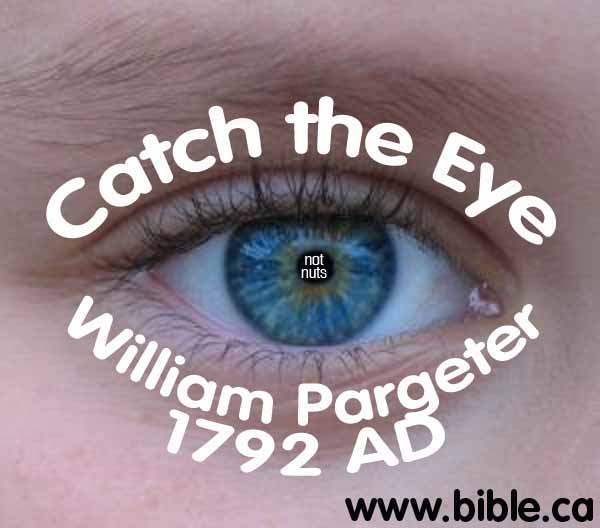
C. Means of Deflection
- The idea with deflection is like hitting your finger with a hammer, in order to forget you have a head ache. The inane were "brought down to a weak state of idiotism" so they were simply no longer willing to act insane... it was too much work.
- "This genus includes all the means included in the method of Sandtmann-Horn, even though some of these have already been mentioned under the first genus. These are the remedies referred to by Sandtmann in his paper as indirect-psychic, or counterstimulating, or pain-producing, and their basis is "the law of peripheral antagonism against the central tendencies." (Textbook of Disturbances of Mental Life and Soul, Johann Heinroth, 1818 AD)
Physical means of deflection
- "In these we shall include only cold, as applied through water. Cold baths, applied to the entire body or to parts of it, result in an abatement of the excitement and anger and produce sleep, as they have a twofold effect as a peripheral stimulant against the central stimulant: by reducing the unnaturally intense action of the heart and of the blood vessels, and by arousal of fear. Even merely washing the head with cold water, enveloping the head in wet towels, especially if the hair has been shorn, has a beneficial, deflecting effect, as can be seen from the fact that the coldest compresses immediately become hot. A sudden immersion of the excited patient in cold water and the application of shower baths by means of sprinkling or hosing, or pouring cold water from above, are preferable to all other applications." (Textbook of Disturbances of Mental Life and Soul, Johann Heinroth, 1818 AD)
- Sternutatories: a gas designed to incapacitate by severely irritating the respiratory passages
- "Excitants of the skin and of the general feeling, strong frictions and brushings, tickling, itching and stinging by insects, bedbugs, ants, maggots; whipping with nettles; birching; blistering plaster; mustard plasters, douches, setons, but only on the most remote parts of the body, since when applied to the head, the excitation only mounts moxa [Chinese Moxibustion: mugwort herb processed into a punk that is lit and burns the skin], glowing iron, burning sealing wax. raging patients were cured by inoculation with smallpox; melancholics cured by pustules, insane cured by psoriasis and scabies, cured a demented patient by inoculating him with scabies, skin eruption produced by rubbing in Autenrieth's ointment. Plunging the patient into cold water was recommended and very successfully employed by Reil" (Textbook of Disturbances of Mental Life and Soul, Johann Heinroth, 1818 AD)
- Chiarugi recommends the suspension of the patient by ropes
- "Cox's swing machine ... its symptoms and results: vertigo, fear, paleness, anxiety, nausea, vomiting, bowel movement. The powerful shock to the disposition subdues even the most refractory patients. Further results are tiredness, sleepiness, and a deep gentle sleep, which often lasts for many hours. According to Cox, reason often returns on awakening, and the patient becomes more receptive to other treatments." (Textbook of Disturbances of Mental Life and Soul, Johann Heinroth, 1818 AD)
Pharmaceutical means of deflection
- Emetics. emetics are preferable to all other medicaments; they have proved to be very effective in all types and all degrees of mental disturbances, and even in all stages of any one mental disturbance
- Purges, digestives, and enemas. This group includes black hellebore, first and foremost. As is well known, the entire psychiatry of the ancients is based thereon, but they had nothing else with which to affect the intestinal tract. The present author never noted any effect of these enemas, in spite of prolonged observations.
- "The use of hellebore in maniacal diseases; the choice, preparation and administration of that vegetable; the preliminary remedies and precautions adopted to promote its action and to prevent its pernicious effects, formed among the ancients a regular body of doctrine. Experience proved that this drastic sometimes produced violent hypercatharsis, obstinate vomiting, convulsions, inflammation of the intestines and even death. The reader is referred for a detailed account of this subject to the articles Ellebore and Elleborisme in the Encyclopedie Methodique. Whether we consider its empyrical administration or the unfounded theories and superstitious fancies which in some instances sanctioned its employment, the disuse into which this remedy is fallen, ought to cause little regret." (A Treatise on Insanity, Philippe Pinel, 1806 AD)
- Counterstimulants in the narrow sense of the word. Here, tartar emetic in refracta dosi must be mentioned first. It produces nausea and affects the nervous tissues of the stomach.
Psychic means of deflection:
- "influencing of the patient by fright or intimidation, but also by the magic force of music, by viewing beloved objects, by a stay in the open in pleasant surroundings, good diet, baths, aromatic, iron-containing mineral waters, cinchona, the so-called nervines, skin irrigations maintained, where necessary: healthy air and healthy surroundings, staying and exercising in the fresh air, getting used to some activity, even if only a mechanical one, orderliness, cleanliness, but most of all: excitation and exercise of spiritual energies; exercise of the reason and of the will by a series of exercises of various kinds and degrees, schooling, discipline: arranging mixed objects, such as sorting dried fruits and pulse vegetables according to their kinds, sorting money, etc.; counting, measuring, computing, reading, writing, memorizing and recitation of texts, catechism, exercises of the mind even when playing, briefly, education, resembling that of a child, the exercises being adapted to the sex of the patient. Punishments and rewards, adapted to the receptivity and tendencies of the patients must not be forgotten, the hunger cure, the nausea cure, the douche, the swing machine, physical labor: gardening, wood sawing, wood cutting; distractions such as running errands, copying letters, copying in general, proofreading (for those who can and want to do it); counting and sorting of coins; putting together maps cut up into pieces, doing jigsaw puzzles, etc., amusements, music, reading, light conversation, striking reasoning through witticisms, through deduction ad absurdum (Pinel). Games which occupy the mind: cards, chess, "toccatille"; occupation with favorite objects: painting, drawing, drawing maps, copper etchings; natural history specimens, such as stones, plants, in-sects, etc. There is no limit to this kind of inventiveness, as was conclusively proved by Reil." (Textbook of Disturbances of Mental Life and Soul, Johann Heinroth, 1818 AD)
D. Means of Excitation (for depression)
- Historically, depression was generally called melancholy. Sad, quiet, listless, unmotivated, lazy people, were given these treatments in order to "cheer them up" a little.
- "Elemental stimulants: stimuli exerted by fresh air, light, heat (tepid or warm baths; the warmth of sunlight), and cold, douche, electric and galvanic shocks, and the excitation method of vital magnetism, Much exercise in the fresh air, work, play, travel, exertion, healthy sleep, all these are the best tonics." (Textbook of Disturbances of Mental Life and Soul, Johann Heinroth, 1818 AD)
- Externally irritating and deflecting medicaments which produce redness of the skin and blistering: rubbing the body with the hand, a flannel cloth, etc.; massages where applicable, rubbing tartar emetic ointment into the shorn scalp; scalp scarifications, scalp cuppings, and maintenance of the irritation thus produced by application of cantharides powder; moderate movements of the swing machine; after a suppressed tendency to hemorrhoids: leeches in the anus; after suppressed skin eruptions, dried ulcers: return of the same or similar skin irritations, artificial ulcers, etc.
- Pharmaceutical stimulants: These include opium, naphthene, phosphorus, essential oils, mustard, and vanilla., medicaments also include nutmeg, pepper, galangal, castoreum, China tea, veronica, sage, peppermint and balm-mint drops, lavender, rosemary
- External and surgical stimuli: Tobacco, mayflowers, marjoram, balm-mint, white hellebore, powdered guaiacum, powdered euphorbium, the vapor of boiling hypochloric acid (Pargeter, p. 67). 2. Irritation of the skin by blistering plaster, douches, setons; rubbing the skin with the hand, with a flannel cloth, with a flesh brush, whipping with nettles, birching, scarifications. Inoculations with scabies and other skin eruptions also belong to this group.
- Dietetic stimulants: These include wine, coffee, cocoa, malt-rich beers, a meat diet, cardamon, anise, fennel, cinnamon, calamus, naphthene. Musk, wine posset, warm donkey milk or goat milk straight from the animal, light, stimulating beer, good quality old wine (Rhenish wine), light roast meat dishes. Let the physician show a pear, an apple, a piece of cake to an idiot and thus make him get up, come nearer, stretch out his hand, make a spoken request.
- Psychic stimuli or means of excitation: flowers, natural produce, brightly colored toys (kalei-doscope), sounds in general, such as the sound of bells, trickling water, and most of all, music, mechanical work, artistic work, conversation, games, especially open-air games (bowling, etc.). For the will: compulsion to activity and to an orderly life, again rewards and punishments, severe and mild ones, lively, merry companions, music, walks, again work and play; awakening of lively affections and passions; the exciting effect of fear, fright and, if possible, joy
- Locking out of room: "The matron, for instance, was ordered to "Acquaint the Physician when ever any of the Patients (without particular Sickness) take to their Beds," while those that were "low Spirited or inclinable to be Mopish" were to be "Obliged to get up ... Turned out of their cells, the Doors Locked, that they may not creep back again to their beds"- a provision that allowed the maidservants to go about their duties less troubled, cleaning cells and galleries.'" (Undertaker of the mind: John Monro, Jonathan Andrews, Andrew Scull, 2001 AD, p 106)
E. Means of Calming (for manics)
- These techniques were applied to hyper, manic, out of control people.
- "direct: A well known voice, the nearness of a beloved person, will do wonders; so will the recovery of a jewel case with its contents. Music. Religious objects. The proximity of holy places and holy objects, the execution of holy rituals with all their pomp and glory, have their effect on dispositions for whom the formality of religion is an object of faith. Hence, the miraculous calming effects and recoveries produced in places of worship, by holy pictures, etc. in antiquity, the Middle Ages, and our own times. Terror-inspiring objects, and effects which they produce." (Textbook of Disturbances of Mental Life and Soul, Johann Heinroth, 1818 AD)
- "Indirect: 1. Stillness, solitude, darkness. Cold, applied by means of water. Showers; pouring of cold water over the head, cold compresses on the shorn head, evaporation of naphthene on the head. Vital magnetism: the calming method. 2. Emetics and purgatives; the nausea treatment; calomel, niter; camphor with vinegar and niter, mineral acids; digitalis; aqueous extract of cherry laurel; narcotics in general, in the absence of contraindications. 3. External deflecting means, namely, blistering plaster. Leeches, bloodletting, if the circumstances permit. 4. Very light, cooling diet: frequent drinks of water, much juicy, acidulous, water-containing fruit: strawberries, raspberries, red currants, grapes, etc., the lightest vegetables, which do not produce wind, served as a thin broth without meat, light fish, white bread only, generally frugal meals, even hunger cures, sleep and everything which produces natural sleep. By inducing fear: the glowing iron instrument, simulated lightning and thunder; a perfectly dark, perfectly still cellar; or else a deafening noise in a dark place, as in the depths of a fountain; sounds of squibs, pistol shots, etc. We may add our advice, namely electric shocks from a galvanic battery given to the patient in the dark, will be quietened by frightening impressions." (Textbook of Disturbances of Mental Life and Soul, Johann Heinroth, 1818 AD)
Conclusion:
- Regardless of the differences in opinion as to what caused insanity, (bodily disease vs. mind choices) the same cures were employed.
- Those who believed insanity was caused by a bodily disease (melancholy blood, spleen, nerves, blood vessels of the brain, chemical imbalances) used these treatments to shock the body and control the will.
- Some also believed insanity was caused by sin, choices and human freewill, but it had a direct effect of harming the physical body. These used these treatments to shock the body and control the will.
- Of course, the historic majority opinion was that insanity was caused by sin, choices and human freewill and not a bodily disorder. These used these treatments are a form of coercion and punishment to correct bad choices and behavior of the insane.
- Today, chemical psychiatry continues these historic methods of discipline, coercion and control in new sanitized forms. Straitjackets, confinement and isolation cells, locks on doors are still in use. The new chemical methods are all the Neuroleptic drugs replaced many of the older physical forms of discipline, coercion and control. People today are drugged into submission which removes the need of corporal punishments like birching.
- Looking back with the modern eye of science, it is clear that insanity is not a bodily illness but a spiritual choice of conduct. Chemical imbalances of the brain are as mythical and quacky as melancholy blood or bloated blood vessels of the brain. There is no more proof that insanity it caused by Chemical imbalances of the brain, as there was that melancholy blood or bloated blood vessels was the cause.
- What we left with is the tombstone of modern psychiatry. It is dead. It has failed.
- Since chemical imbalances are a myth, just like melancholy blood, this brings some truth to the real reason why drugs are prescribed to the insane. They are not to correct a chemical imbalance, but to coercion and punishment to correct bad choices and behavior of the insane.
- People never lose their freewill and are always in full control of their actions. There is always a reason to explain why a insane person has chosen to act the way they do. All modern treatments must be voluntary. Forced confinement in a mental hospital must be abolished. If someone disturbs the public peace, commits crimes or physically assaults another, they should be charged and thrown in jail. It is time we stop excusing sinful and criminal behavior because a doctor calls a person insane.
- Insanity has always been characterized by the sins of anger, selfishness, rebellion, laziness, violence, assaults, lack of obedience and all the other things young children get spanked for. Today, society provides three methods of teaching you to behave: 1. your mother 2. your church minister 3. the jail 4. the asylum. Now that we understand the true causes of insanity, we really have no need of asylums.
- There is no "get out of Judgment Card" for a person's behaviour on the basis of mental illness or insanity. Every man will be held accountable for every action. So should society among the living. We don't need asylums today because they merely duplicate the function of jail.
- See also: Historical Survey of Mental illness etiology 1500 - 1900
|
|
||||
|
Today's Psychiatric chamber of horrors: more |
||||
|
(leucotomy or psychosurgery) 1935 |
Electroconvulsive Therapy (ECT) 1938 |
Transcranial Magnetic Stimulation (TMS) 1985 |
Vagus Nerve Stimulation (VNS) 2005 |
Deep brain stimulation (DBS) 2009 |
|
|
||||
By Steve Rudd: Contact the author for comments, input or corrections.
Send us your story about your experience with modern Psychiatry

